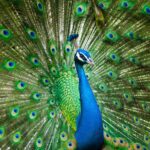Have you ever wondered why dragonflies are so often used as symbols? The dragonfly is an ancient creature that effortlessly glides through the air, seeming to dance on the wind. Its delicate beauty and graceful movements have long inspired people to use it as a symbol of change, transformation, adaptability, and self-realization.
This article will explore how symbolism associated with the dragonfly has been used throughout history and its relevance today.
The dragonfly’s association with change dates back thousands of years; in some cultures, it was believed that dragons could transform into dragonflies when they wished for greater agility. It has also been used as a spiritual symbol in various religions – from Ancient Egypt to Japan’s Shinto – representing renewal and a lightness of being.
Across different cultures worldwide, the dragonfly is an emblem of hope and strength during difficult times due to its ability to move forward despite life’s obstacles.
In modern times, many people still find meaning in the symbolic nature of the dragonfly. As our world continues to experience rapid environmental and social changes, understanding the power behind these symbols can help us remain focused on what matters: taking charge of our transformation process while embracing new challenges ahead. Let’s take a closer look at why the dragonfly remains such an important symbol today!
The dragonfly has long been associated with symbolism and lore, often regarded with a sense of awe and mystery. Surprisingly though, the creature’s significance can be found in ancient cultures all around the globe. While it may seem that they were considered nothing more than annoying insects to swat away, they had much more meaning.
In many parts of Asia, particularly Japan, the dragonfly is seen as a symbol of courage and strength, one who perseveres through life’s struggles while never losing sight of their goals.
In some Native American tribes, the dragonfly is believed to represent change or transformation – which makes perfect sense considering how quickly these creatures move!
Finally, even in Europe during medieval times, the dragonfly was thought to be a magical being sent from Heaven whose presence brought good luck.
It’s clear then why this tiny creature has become so highly respected over time: embodying virtues such as bravery and resilience throughout multiple cultures worldwide. Even today, its power continues to captivate us.

Some ancient cultures saw the dragonfly as a symbol of transformation and change due to its metamorphosis from an aquatic nymph into an aerial adult. In contrast, others viewed it as a messenger of hope. Various interpretations have been attributed to this insect from Japan to Europe throughout history.
Here are three ways different cultures have represented the dragonfly:
- In Japan – Dragonflies were considered symbols of strength, courage, and happiness. In feudal times, samurai wore them on their clothing for protection in battle.
- In Scandinavia – They were believed to be magical creatures that could grant wishes when caught and presented with offerings like coins or flowers.
- In Christianity – The dragonfly was associated with Jesus’s resurrection because they can lay dormant before emerging anew from their cocoons – just like Christ did after his death and burial!
The symbolism behind the dragonfly has transcended time and culture, making it one of the most iconic insects today. It is even seen as a source of inspiration by many who strive for personal growth and renewal, something we all can relate to no matter where we come from or our beliefs.
The mystical dragonfly has been a symbol of spiritual power and growth for centuries. With its colorful wings and agile flight, this creature is seen as an omen of good luck in many cultures worldwide. But have you ever stopped to ask yourself: what does the symbolism behind the dragonfly really mean?
Well, according to ancient folklore, the dragonfly symbolizes transformation and change. It’s said that when these bugs appear, they bring messages from the spirit realm – whether those are words of warning or blessings of prosperity is yet to be determined!
The dragonfly also appears in many religious beliefs, representing a connection between Heaven and Earth. In Christianity, for example, it’s thought that their appearance brings joy and peace to one’s life; while Buddhists view them as symbols of courage and strength. So whatever your faith may be, there’s no doubt that this insect carries with it powerful symbolic meaning.
The dragonfly is known for its remarkable color combinations, which often have a symbolic meaning. Many insect species can be found in shades of blue, green, yellow, and orange. The blues are believed to symbolize power and strength, while the greens represent transformation or change. Yellow typically represents joy and optimism, while orange conveys passion and energy. Each hue has a more profound significance reflecting the creature’s life cycle from birth to death.
The unique coloring of the dragonfly also serves as a warning signal for predators who may attempt to eat it. Some research suggests that certain hues may act as camouflage against birds or other potential threats. This helps explain why many varieties feature different colors on their wings, bodies, and tails – all designed to confuse any would-be attackers.
Dragonflies provide insight into nature’s beauty and offer essential lessons about adaptation and survival through careful observation and analysis of their intricate patterns and vibrant colorations. With such symbolism embedded in every aspect of their lives, they are truly captivating creatures worthy of greater appreciation.

The dragonfly’s life cycle is nothing short of miraculous. It is a prime example of nature’s never-ending cycles and the beauty it can create on Earth. From its humble beginnings as an egg to its final moments as a fully mature adult, this creature symbolizes many things people can use daily.
| Symbolism | Description |
|---|---|
| Renewal | This a reminder to start anew |
| Transformation | The ability to adapt & evolve |
| Freedom | Liberation from external pressures or influences |
| Maturity | Becoming wiser & more experienced with age |
| Strength | The power within oneself to overcome adversity |
Each stage of the dragonfly’s life marks a special moment for us to recognize and appreciate. From being born as nymphs living underwater and emerging into adulthood, where they take flight into the sky, there are so many critical points along the way that represent change and development. With each new phase comes fresh opportunities to learn something new and experience internal and external growth.
As humans, we can strive to be more like these creatures by taking advantage of our transformations while embracing every single bit of knowledge gained along the journey. We must remember that no matter how tough life gets, strength will always come in all shapes – just like the mighty dragonfly!
Dragonflies are widely used in art and decor, from paintings to sculptures. They can be found in many homes as decorative pieces or artwork that symbolize the beauty of nature and freedom of spirit. Dragonfly decorations have become increasingly popular for home decoration, office spaces, and outdoor areas.
The dragonfly symbolizes transformation and spiritual awakening, so it often appears in various works of art, such as sketches, drawings, and even digital illustrations. Artwork featuring a dragonfly typically shows its wings spread wide open to signify movement, energy, and joyfulness. The vivid colors on their wings also represent creativity and self-expression. Many people use dragonfly decor as a reminder to stay present and follow their dreams without fear or worry.
Artists who create dragonfly artwork draw inspiration from the symbolism behind this creature’s ability to move swiftly while carrying messages of hope across all cultures worldwide. This makes them an ideal subject matter for any form of creative expression, whether painting, sketching, sculpting, or making jewelry with beads in the shape of these graceful creatures. Including dragonflies in one’s artwork will add a unique perspective to whatever message one seeks to convey, no matter the medium used.
The dragonfly, with its delicate wings and iridescent body, has been a source of fascination for many cultures. But dragonflies also have an essential place beyond their aesthetic beauty in the environment.
They are both predators and prey, controlling populations of insects like mosquitoes that can spread disease; they also provide food for birds and other animals. As apex predators, they play a vital role in maintaining an ecological balance within aquatic ecosystems.
Dragonflies offer us more than just environmental benefits; they can indicate water quality and pollution levels. Dragonfly larvae live in freshwater habitats. The adult dragonflies’ ability to thrive will be affected if these habitats are polluted or degraded due to human activities such as mining or fracking. Scientists often use certain species’ presence (or absence) to gauge a particular habitat’s health.
Given their importance in nature, it’s no wonder why dragonflies are so beloved worldwide! In some cultures, they represent transformation and new beginnings, while others see them as symbols of luck and joy; still, others believe they bring messages from ancestors living in spirit form. Their significance goes far beyond art or decor – they’re reminders that we must protect our environment for future generations.
Dragonflies have long been popular in jewelry, particularly as a reminder of the beauty and fragility of nature. It’s an insect often seen gliding through the air with its delicate wings. The dragonfly can be found on many jewelry pieces, from earrings to necklaces or charms for bracelets. In some cultures, wearing dragonfly-inspired jewelry is said to bring luck and good fortune.
The symbolism associated with the dragonfly makes it an ideal choice for jewelry designs. As previously mentioned, it symbolizes transformation since they are known to undergo a metamorphosis during their life cycle. The dragonfly is also seen as a representation of joy and new beginnings because of how quickly they move through the sky. This creates a sense of hope that resonates with those who wear such items.
It’s easy to see why dragonflies are so popular in jewelry today; these pieces look beautiful and have meaningful symbolism. Whether you’re looking for something special for yourself or someone else, there’s sure to be something perfect out there!

The dragonfly, with its scientific name of Anisoptera, is a fascinating creature. It has long been held in high regard across many cultures and religions worldwide due to its symbolism. In some belief systems, it represents change, transformation, adaptability, and self-realization; in others, it can mean good luck or prosperity. All these meanings indicate this mysterious insect’s unique place in our lives.
So how does one attract dragonflies to their garden? Well, there isn’t any single answer to this question, as different species have different preferences when it comes to feeding and habitat requirements. However, providing them access to water sources like ponds or streams will increase your chances of seeing them in your backyard. You could also add plants that produce nectar which the dragonflies feed on, such as roses or lavender – this would surely benefit everyone!
Fortunately, dragonflies aren’t endangered at present. However, they’re still vulnerable to environmental changes like climate change and pollution, so we must take steps to protect them if we want to continue admiring their beauty. To summarize my research, I believe that by understanding more about the symbolism of the dragonfly and taking care of our natural environment, we can enjoy these extraordinary creatures even more!







